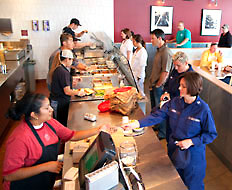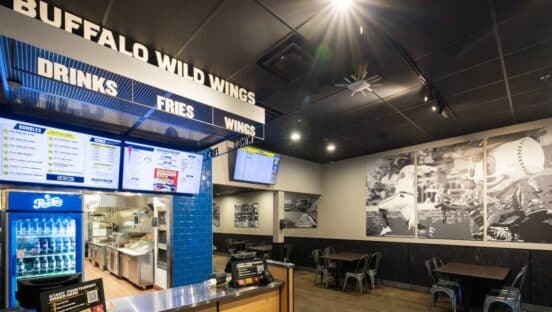Every year, many of us anxiously await the release of Technomic’s Fast Casual Top 100 report. Technomic’s Darren Tristano, one of the most knowledgeable people in the industry, gave me an interview and a sneak peek at the report. Here are his thoughts, followed by a few of my own.
Darren, what is the size of the fast-casual segment (2010)?
We believe that 95 percent of the fast casual market is the chains. We track 344 chains to get to sales of $21−$22 billion in sales. (See my analysis at end for lots more data). However, there are such different views of the definition of fast casual that it is hard to have a definitive answer.
What struck you as most interesting when you put this study together?
That the fast casual companies continue to outpace the quick-service and the full-service markets. That is obviously good news and strong news about the segment and consumers’ interest in it.
What comes to mind is there is still strong unit growth here in a year where we have seen units contract by nearly 1 percent. These chains are doing $1 million-plus per unit.
Another thing that struck me was that some of the older fast casuals have aged so quickly and are losing relevance, unlike chains in other segments like Steak & Ale who died slowly over many years.
The lifecycle of concepts in fast casual seems to be shortening and tightening up.
Is this true for all segments?
I think it is true for all segments, although some casual-dining chains have been very slow to do so. In quick service look at how McDonald's is tearing them down and building them up instead of expanding old locations. They are focusing on the efficiency, the build out, the double drive thrus, and throughput. They are focusing on the unit-level profitability, and that is very relevant compared to the older units that struggle with the efficiencies and don’t recognize the technology improvements.
The new KFCs, Taco Bells, and McDonald's are all much more closely aligned with the interiors of fast casuals, so they are going to attract that consumer who is still price-minded because of the upgraded interior and, in many cases, the upgraded product.
Taco Bell is a good example of upgraded product at their new locations. Some full-service chains like Denny’s or IHOP are looking at doing express units to save costs and grow saturation, also.
So some of quick serves are doing a better job at adapting than some of the older fast casuals?
Yes. Even Chipotle has said we are seventeen years old, and they are going to be upgrading some of their locations to become more efficient and offer different types of seating.
I believe this has to be done because consumer needs are changing so quickly; you can’t wait too long to upgrade a location to the next best thing. However, some concepts can’t adapt older units (i.e. shrinking the size of the box).
What do you see in the future for fast casual?
I see continued growth by the leaders with more rapid growth in under penetrated sub-segments like Asian and burger. There will be broad competition with winners and losers, but there is no indication that the fast-casual segment is going to slow down anytime soon.
OK, so here’s what I, George Green, found interesting about the study.
Darren and Technomic were nice enough to let me crunch some numbers from their report. Here’s what I found.
Fast casual is still where the growth is. In terms of the top 500 restaurant chains, total limited-service restaurant sales went up 2.6 percent in 2010, and quick-service sales went up 2.2 percent. In comparison, fast casual grew sales by 5.7 percent. In terms of unit growth, the top 500 chains grew .6 percent, quick serves grew .3 percent, and fast casuals grew a whopping 3.4 percent.
In terms of sales, the top 100 fast-casual chains accounted for $18.86 billion or about 85−89 percent of the estimated $21−$22 billion fast-casual market.
Technomic breaks down the fast-casual segment into nine sub-segments (with # of concepts in FC100):
- Mexican (20)
- Bakery/Café (18)
- Other Sandwich (16)
- Hamburger (11)
- Chicken (9)
- Pizza (7)
- Asian/Noodle (6)
- Salad (4)
- Specialty (9)
Bakery/Café and Mexican are by far the largest segments with each sub-segment accounting for more than 22 percent of the sales for the entire top 100. This isn’t surprising since Panera and Chipotle are the largest fast-casual chains.
When you remove these two huge companies from the total sales tabulation, Mexican is significantly larger than bakery/café and, surprisingly, larger than any of the other six sub-segments, as well.
All of sub-segments are dominated by a market leader at least 29 percent larger in terms of sales than the No. 2 chain in that sub-segment.
The top five chains in the Top 100 are:
- Panera
- Chipotle
- Panda Express
- Zaxby’s
- Five Guys
Together they accounted for $7.56 billion in sales or 40 percent of the sales of the top 100. To break that down even further, that’s about 34−36 percent of the estimated total fast-casual market.
Only the top three chains in the top 100 have more than $1 billion in sales, and 62 chains have less than $100 million in sales.
What does all this mean? Fast casuals are far from over. The segment survived and thrived during a terrible economic downturn and is in a position to continue growing during the recovery and for years to come.
Eventually, the law of large numbers will take hold and the explosive percentage growth by fast casuals will not be possible, but absolute growth will still happen. As Darren alluded to earlier, there will be increasing competition as concepts outside the segment adapt to compete and new fast-casual concepts are created.
If you think about it, there have been very few, if any, new chains in the quick-service and casual-dining segments over the last decade. The fast-casual segment is the land of entrepreneurs and new ideas.
A rise in “small luxury” expenditures and “trading up” in the 90s and early 2000s caused the unbelievable growth of Starbucks and Panera before to the recession. Many thought that the recession might put an end to this as “new normal” spending patterns took hold. However, the continued growth of fast casuals shows there is still great consumer demand for the quality product and the overall experience provided by fast-casual restaurants.












